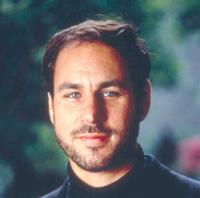home | metro silicon valley index | music & nightlife | review

Cello Charge: Gary Hoffman's playing earned him a fervent encore.
Dmitri Days
Symphony Silicon Valley celebrates Shostakovich's 100th birthday
By Scott MacClelland
THE APPETITE in San Jose for Shostakovich is huge. At least that's the strong impression one got from the audience reaction Sunday afternoon to the Soviet composer's first cello concerto when Gary Hoffman soloed with Symphony Silicon Valley. The astringent, bipolar piece brought most of the audience to its feet in a demonstration that would not be quelled until Hoffmann agreed to an encore.
By the time Shostakovich wrote the concerto (for Rostropovich) in 1959, the much-feared Stalin had been dead for six years. But Stalin's spirit haunts the piece, kept all too alive by his music tsar, Tikhon Khrennikov (who, despite his reputation as a hatchetman, is a quite good composer and, to the dismay of his enemies, still alive). By that time, Shostakovich had already made conspicuous use of his own monogram in music (D, E-flat, C, B), most often when the desired effect is irony. (In fact, he used it in this concerto in a rearranged form for its second theme.) Meanwhile, the main theme, which permeates the piece, is a motto of four notes (G, E, B, B-flat) that cannot fail to suggest the monogram—especially when it stabs at a favorite folk song of Stalin's in the final movement.
San Francisco.com Real Estate
Moving to the Bay Area just became easy. Let San Francisco.com show you all the homes currently for sale.
San Jose.com Real Estate
Relocating to San Jose or Silicon Valley? Let San Jose.com introduce you to some expert area real estate agents.
Aside from the four-note motto, the concerto is less tuneful than intensely personal. This grist for Hoffman's mill culminated in the solo cadenza, darkly ruminating for most of its six minutes only to explode in wild mania just before the frantic finale. In the first and last movements, the composer uses the winds for raucous cackling, further isolating the solo cello whose anguish rises to impassioned heights in the second movement, only to fade quietly in a series of ethereal harmonics, accompanied by celesta and timpani. Recalled to the stage (with his legendary 1662 Amati) Hoffman explored the shadowy recesses of the sarabande from Bach's Cello Suite in D Minor.
The concert was guest-conducted by Martin West who, though rarely looking directly at the soloist, displayed a polished rapport. His balletic instincts (he is now with the San Francisco Ballet) were obvious in the program-opener, a full-bodied reading of Fauré's incidental music for Maeterlinck's play Pélleas & Mélisande, four luscious orchestral movements (largely orchestrated by Charles Koechlin, who wrote fascinating symphonic poems inspired by Kipling's Jungle Book) that highlighted the woodwinds, especially the flute of Maria Tamburrino and, in the popular Sicilienne, Dan Levitan's harp.
Oboist Pamela Hakl took a sweet cameo in the second movement and got another, of more soloistic proportions, in Bizet's Symphony in C, which ended the program. Anyone who has seen the Balanchine choreography for full company of the piece will have a hard time hearing that music without those images. Ebullient with tunes and toe-tapping rhythms, the adolescent masterpiece is yet another homage to Haydn's classical model. It takes no great leap of imagination to also conjure Schubert, Gounod and the composer's own Carmen. Under West's baton, the orchestra sparkled with clarity and élan, while the California Theatre's acoustics once again worked their own seductions.
Send a letter to the editor about this story.
|
|
|
|
|
|
